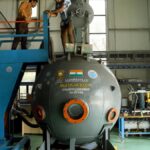Table of Contents
Significance: Understanding the Fragility of Earth
Every astronaut comes back with the realization about the fragility of the earth, according to Rakesh Sharma, the first Indian to venture into space. He emphasizes the urgent need to stop “ruining” our planet by depleting its resources and highlights the importance of learning about sustainability.
Features: Insights from Rakesh Sharma
Rakesh Sharma, during an interactive session at a museum launch in Kolkata, stated that astronauts have the unique opportunity to see the big picture and understand that our earth is just a pale blue dot in the vastness of space. He believes sustainability should be the primary focus rather than seeking habitable alternatives elsewhere.
Objectives: Promoting Sustainability and Responsible Space Exploration
Mr. Sharma urges all stakeholders to prioritize sustainable practices and safeguard the limited resources available on earth. He emphasizes the need to address the issue of resource depletion and protect the only place known to sustain life.
Effects: Implications for India’s Space Sector
Rakesh Sharma acknowledges the progress made by the Indian space sector and the participation of the private sector and startups in advancing space exploration. He expressed hope that India’s ambitious human spaceflight mission ‘Gaganyaan’ would see more Indian astronauts travel to space, fostering the growth of the country’s space program.
Pros and Cons: Balancing Progress and Sustainability
While the expansion of India’s space sector and advancements in space technology bring numerous benefits, there is a need to ensure that sustainability remains a priority. Balancing progress with responsible resource management is crucial to avoid further harm to the environment.
Fun Fact: Rakesh Sharma’s Stint as an Astronaut
Rakesh Sharma participated in the Soviet Union’s ‘Soyuz T-11’ expedition in April 1984, becoming the first and only Indian to journey into space. His experience as a test pilot prepared him for the unknown, and he approached the mission with confidence and strategic planning.
“I was already accustomed to testing aeroplanes that I never flew before… And so you devise a complex kind of process on how to approach something in the domain of the unknown. You tend to attempt to derisk as much as you can with past data… If it has to work, it will work,” said Mr. Sharma.
Mutiple Choice Questions
1. According to Rakesh Sharma, what is the realization that every astronaut comes back with after venturing into space?
a) The vastness of the universe
b) The fragility of the Earth
c) The possibility of life on other planets
d) The need for interplanetary colonization
Explanation: According to the information provided, Rakesh Sharma stated that every astronaut comes back with the realization about the fragility of Earth.
2. What does Rakesh Sharma suggest people should learn before attempting to find habitable places other than Earth?
a) The history of space travel
b) The importance of space exploration
c) The principles of sustainability
d) The technology required for interplanetary travel
Explanation: Rakesh Sharma suggests that people should learn about sustainability before making attempts to find habitable places other than Earth.
3. During which expedition did Rakesh Sharma venture into space?
a) Apollo 11
b) Soyuz T-11
c) Gaganyaan
d) Challenger
Explanation: Rakesh Sharma was a part of the Soviet Union’s ‘Soyuz T-11’ expedition.
4. What was Rakesh Sharma’s purpose of visit to Kolkata?
a) To attend a museum launch
b) To inaugurate a museum
c) To participate in a space conference
d) To meet with government officials
Explanation: Rakesh Sharma visited Kolkata to inaugurate the Museum of Astronomy and Space Science.
5. What did Rakesh Sharma urge all stakeholders to do during his address?
a) Invest in space exploration
b) Protect the planet through sustainability
c) Collaborate with other countries in space missions
d) Support the Gaganyaan mission
Explanation: During his address, Rakesh Sharma urged all stakeholders to look at ways to be more sustainable for safeguarding the planet.
6. What is the objective of the Gaganyaan project?
a) To explore the Moon
b) To study Mars
c) To launch satellites into space
d) To send humans to space and bring them back safely
Explanation: The objective of the Gaganyaan project is to launch human crew to an orbit of 400 km for a three-day mission and bringing them back safely to Earth.
7. How did Rakesh Sharma feel before the Soviet-Indian spaceflight?
a) Excited and confident
b) Nervous and worried
c) Indifferent and uninterested
d) Curious and curious
Explanation: Rakesh Sharma stated that he was not nervous before the Soviet-Indian spaceflight as he had the experience to tackle the realm of the unknown from his stint as a test pilot.
8. What was Rakesh Sharma’s background before venturing into space?
a) Scientist
b) Astronaut
c) Museum curator
d) Test pilot
Explanation: Rakesh Sharma’s background before venturing into space was that of a test pilot.
Note: The answers provided are based purely on the given information and may not be completely accurate.
Brief Summary | UPSC – IAS
Rakesh Sharma, the first Indian astronaut to go to space, emphasized the fragility of Earth and the importance of sustainability during the inauguration of a museum in Kolkata. Sharma stressed that astronauts often realize the delicate nature of our planet while in space, prompting the need to protect and preserve it. He discouraged the rush to colonize other habitable places before learning sustainability. Sharma also discussed the growing space sector in India and expressed hope that more Indian astronauts would participate in the country’s upcoming human spaceflight mission, the Gaganyaan project, set to launch in 2024.




